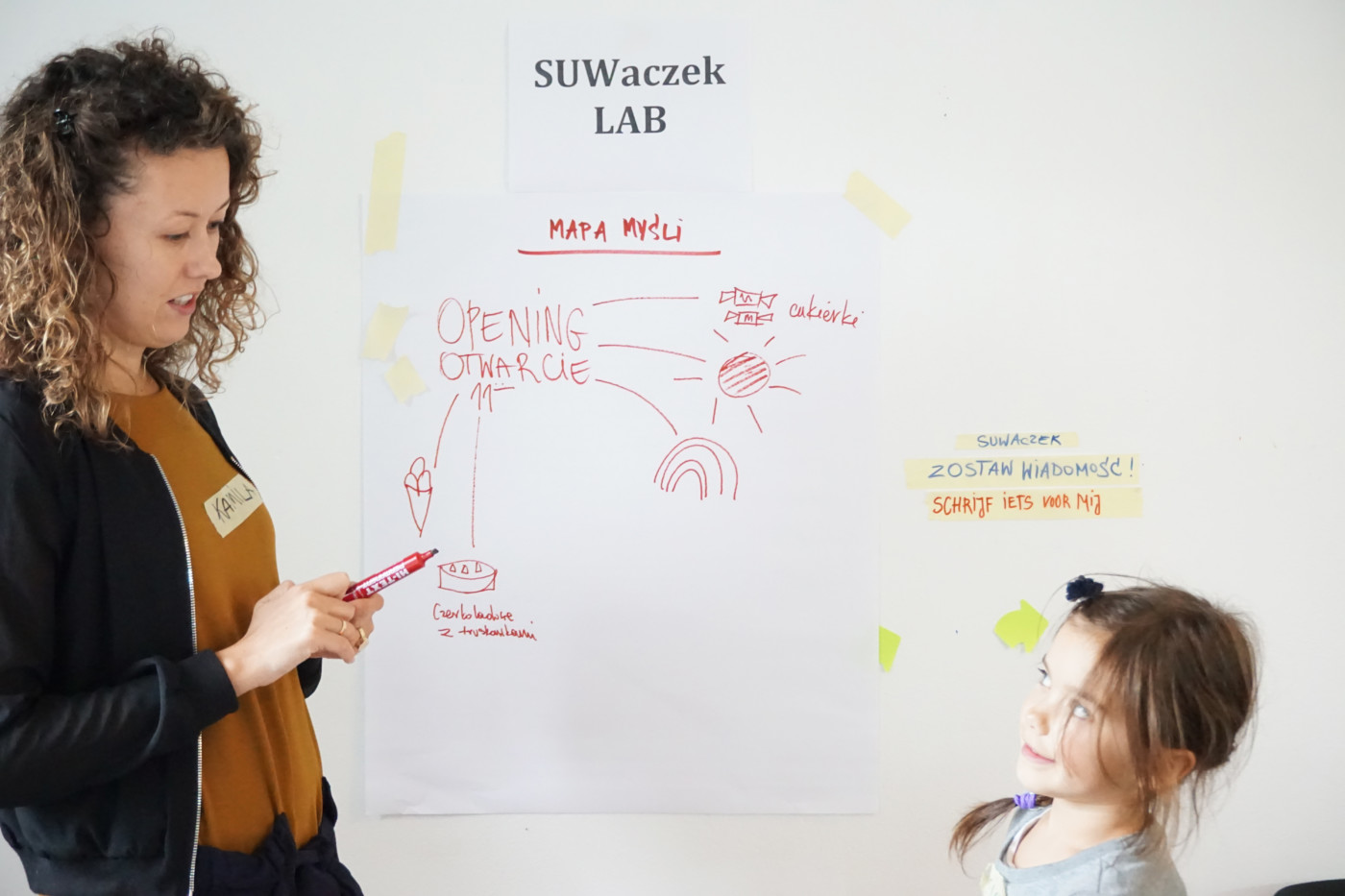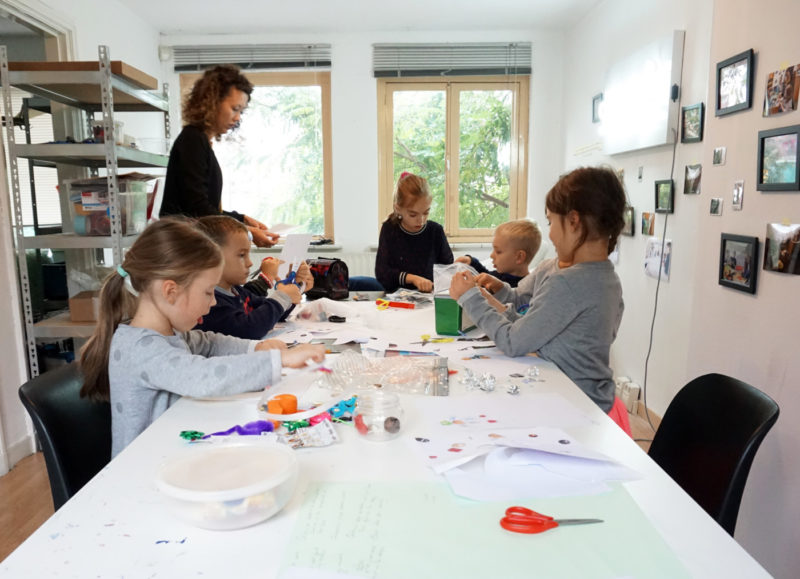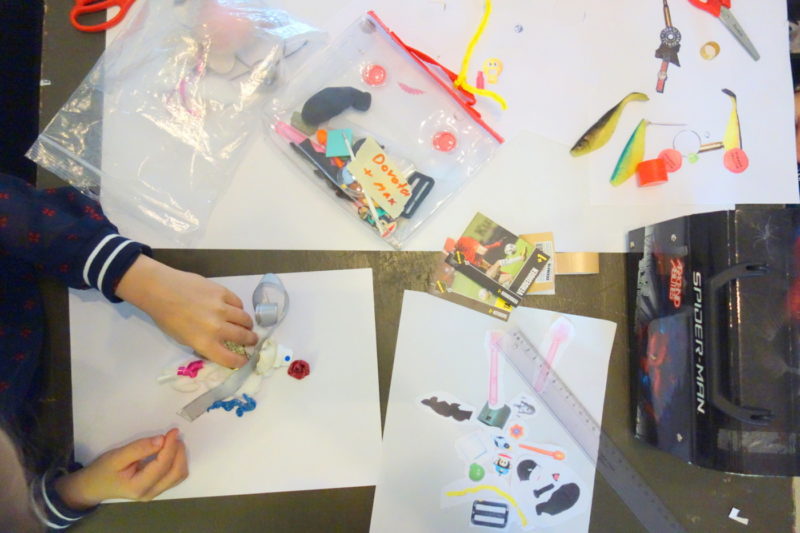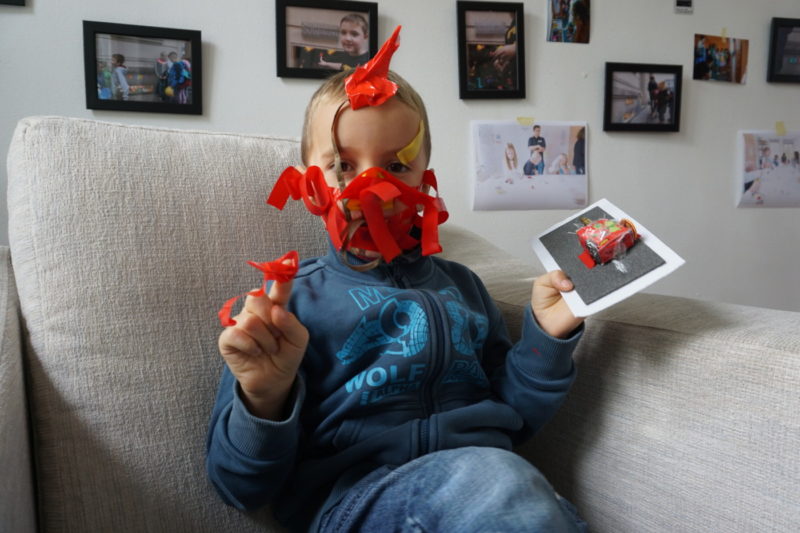 Agenda
Artikelen
Programma
Agenda
Artikelen
Programma

On October 12th, I visited Kamila Wolszczak in her studio at Witte Rook. She is involved in a workshop titled SUWaczek (which translates as ‘zipper’). Children of the Polish School in Breda are working with her towards a pop-up exhibition at the Boschstraat 22 in Breda on October 26th 2019.
I enjoyed observing them while they worked with small treasures the children collected. They were turning these treasures into new objects. Kamila’s approach of the workshop reminded me of ‘How to work better’ (1991), a well-known work by Swiss artists Peter Fischli and David Weiss. This work consists of a list of ten edicts: a motivational description of their process. For example: edict number six states ‘’Accept change as inevitable.’’ While it is a description of their working method, it also serves as commandments or guidelines for behaviour of the rest of the world.
JR: Your pop-up exhibition project Universal Self-supporting Exhibitions (SUW) started off during your time in Wroclaw, Poland. A few years after your graduation you where running Pracownia Komuny Paryskiej 45, a cultural space in Wrocław.
There was a small, street level window, used only in the winter to transport coal into the basements, in the summer people would dump glass bottles and other waste. You cleared it out and eventually used it as the public exhibition space.
A small gesture that evokes wonder and aims to change the world, can you tell us more about the concept of SUWaczek?
KW: Every concept comes to my mind from a question, SUWaczek was the answer to many questions.
Let’s start from the context. It was the year 2016, a very important time for the cultural scene of Wroclaw. At that time Wroclaw was European Capital of Culture. The department of visual arts asked me to be a part of the program “Wrocław- backyard door” and run a studio for artists and the local community. I involved a great local painter and art mediator Krzysztof Bryła and a sociologist Jacek Sterczewski in this collaboration. Our team was running a cultural program for six days in a week. On Fridays and Saturdays I was developing my ideas. It was a program dedicated to local children and families.
I believe that if we want to change something in a city, the start needs to be good, and in this case the beginning was the young generation.
My concept was based on creative participation, dialogue, and exchange. In the studio we were creating concepts, objects, interventions, performances and stop motion animations.
Our theme was the neighborhood “Triangle”, shaped like a triangle it had a bad reputation all over the city.
Many people were afraid to pass through our neighborhood, but we lived and worked there with many adventures and enjoyed it. SUWaczek was a response to those people who didn’t believe in the transformations and to those who didn’t care about public space. We turned on the streetlights on and showed the power of young, local people.

During the workshop / photo by Tomas de Loo
JR: This specific version of SUWaczek is linked to the 75th anniversary of the liberation of Breda, which will also be celebrated in Breda on October 26th. On what level do you connect with this event, why is it being celebrated in Breda and why did you prefer to work with the children of the Polish School since they have no memories of their own regarding the war and liberation?
KW: First of all, October 26th 1944 is a very important date for Breda. In general, liberation day is a beautiful date to celebrate and nowadays freedom is an important value.
Breda was liberated by Polish soldiers and that’s the main link in the story. Some Polish-Dutch families stayed in the city after WWII, some Poles emigrated to the Netherlands for economical reasons. I try to work with Polish communities and make new links between the two cultures. Links already exist, but I believe that we need to discover new connections everyday. That’s the reason I asked children to collect 75 objects which are connected with Poland and Breda and create a new creative heroes, based on that. I don’t want to talk with children about the history from books, I would like to hear their own stories from their pockets, abstract, maybe real or maybe not, but based on bilingual and multicultural process of growing up.
JR: Why did you feel the need to start art-mediation projects like SUWaczek?
KW: Every project comes from a need of society, friends, neighborhoods or public space. My art is site-specific, I believe in a better world and the power of communities. Art and art mediation are tools, a magic language to create new beginnings.

After the workshop we talked about Kamila’s artistic processes and it occurred to me she must look at the world, inside and outside her, in a kaleidoscopic way. Her artistic approach therefore covers a variety of media and perspectives such as workshops, performances, drawings and working in abandoned buildings.
During the workshop I observed that while Kamila starts from a clear concept, she focuses on providing the children with materials and questions rather than steering them towards a result that is a direct visualization of that concept.
JR: About one year ago, you moved from Poland to Amsterdam, with the notion that you could create work everywhere. While this remains true, you stumbled upon unexpected difficulties, mostly because you didn’t speak Dutch at all. So you decided to start learning Dutch.
This I think pinpoints the way you work; you stumble upon something unexpected and then figure out a way of appropriating the questions it raises, resulting in ongoing processes of visualizing and sharing them through your work.
Likewise, you met Dominika Borkowska during a BlaBlaCar ride and now work with her as performance duo PARAperformance. How do you experience contingency and how do you keep your focus while at the same time you are open to ‘’accept change’’?
KW: I experience changes as diversity which gives added value to my work. This results in many new collaborations, friends, concepts and adventures. It’s not always positive or fun, but I treat difficulties as a lesson about myself.
During the beginning of my residency in Breda I didn’t know what the location of SUWaczek would be and if I would reach enough participants. After three weeks of meeting people and many presentations, coffees and cookies I succeeded in finding a great location as well as a group of participants: that’s art mediation.
The most contingent project in my career was “Przesuwanie” in Wrocław. It consisted of 20 walks through the city, each walk dedicated to another district. The walks had from 10 to sometimes 70 participants. Sometimes I need to get lost in the city together with strangers, I know that it’s not just my desire. This is a way to experience life.
I am always creating and thinking about my projects, so when I see a potential relationship or collaboration, I immediately want to develop them. So I focus every time, I need to create priorities for myself. Self-organization and sticking to the plan helps.

During the open studio, October 24th / photo by Tomas de Loo
JR: While during SUWaczek you and the Polish community open up about your stories to Breda, the connection between being Polish and living in the Netherlands is being strengthened by your vulnerable approach. Keeping your concepts close to yourself and at the same following the urge to share them you seem to prefer a gentle approach towards your public. This lines up with your need to set your own boundaries and priorities regarding the execution of your projects. Which set of conditions are necessary for you to create work?
KW: My conditions are participants willing to cooperate, a studio, access to a space in the public space, objects, and time.
I work with participants who are enthusiastic about my proposals and open for dialogue and the creative process. I don’t force anyone because I treat participants as my partners not staff. I prefer to work with three dedicated people over a random groups. I had a project where participants and I weren’t well prepared for engagement in the idea, so we couldn’t finish our project. In another one I was working with two old ladies in their garden and we finished the project successfully. Currently they are running a cultural house for the local community in their district. It’s important to meet a need with an idea and time.
JR: How would you describe the connection between your different projects?
KW: My projects are based on non-hierarchic treatments of participants, concepts and objects. I work with art and people not for people.
The Universal Self -supporting Exhibitions are as a tree with different fruits: SUWaczek with kids, collective walks PrzeSUWania and SUW-exhibitions in non-gallery spaces. My performances are more about the individual relations with single person, with myself and air pollution.
I see many relations between certain points and I work in this field. I think nothing happens by accident and I create with what is happening now.
Inspired by learning more about Kamila’s artistic approach I immediately started writing this article on my trainride home. Are you curious what the children created? You’re cordially invited at the OPENING, the 26th of October at 11 o’clock.